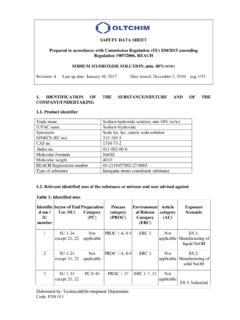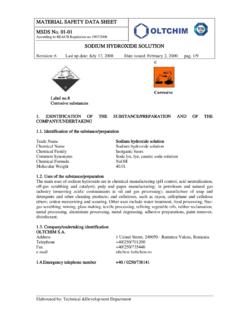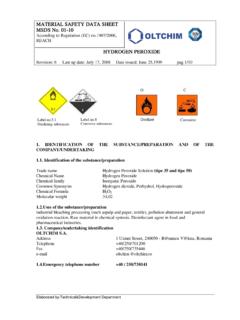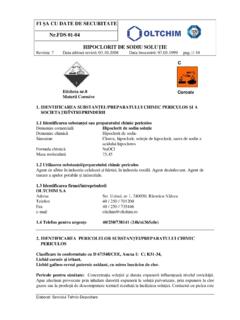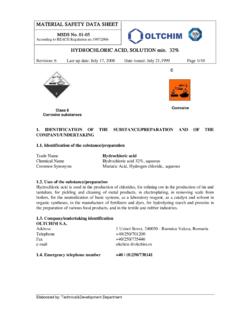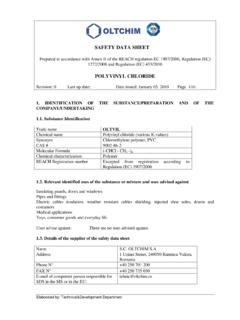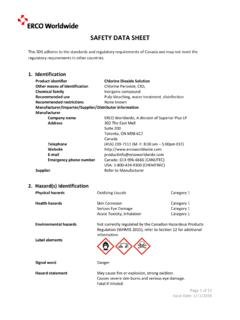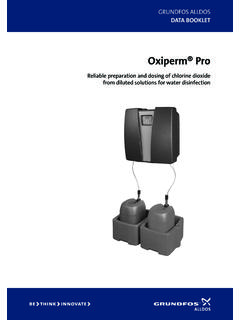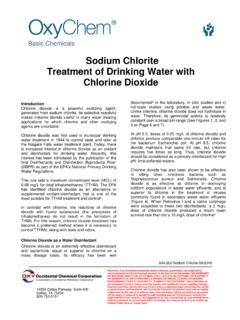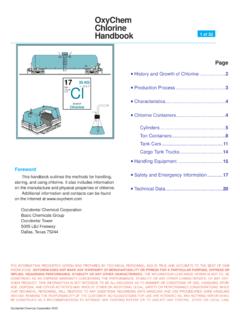Transcription of CHLORINE - Oltchim
1 MATERIAL SAFETY DATA SHEET MSDS No. 01-03 According to REACH Regulation : 5 Last up date: July 16, 2008 Date issued: July 21, 1999 Page 1/12 Elaborated by: Technical&Development Department1. IDENTIFICATION OF THE SUBSTANCE/PREPARATION AND OF Identification of the substance/preparationTrade NameCHLORINE -Liquefied GasChemical NameChlo rineCommon Synonyms-Chemical FormulaCl2 Molecular Uses of the substance/preparationChlorine is used in a number of industrial applications. Its largest use is as a raw material in theproduction of ethylene dichloride, an intermediate for vinyl chloride monomer and polyvinyl chloride(PVC) resins. CHLORINE is also used in the paper industry to bleach pulp, in the production ofchlorinated solvents and chlorofluorocarbons (CFCs), as a disinfectant or fungicide for a variety ofpurposes, including water purification, cooling systems, meat, fish, vegetable, and fruit processing,foot baths, dairy equipment, laundries, and dishwater, as well as for shrink-proofing wool, in specialbatteries (with lithium or zinc), and in the manufacture of propylene oxide and Company/undertaking identificationOLTCHIM Uzinei Street, 240050 - Ramnicu Valcea, RomaniaTelephone+40/250/701200 Fax+40/250/735446e-mailo ltchim Emergency telephone number+40 / 250/7381412.
2 HAZARD IDENTIFICATIONC lass gasesClass 8 Corrosive substancesTToxicNDangerous for theenvironmentCHLORINEMSDS No. 01-03 Revision: 5 Last up date: July 16, 2008 Date issued: July 21,1999 Page2/12EC Classification according to Directive 67/548/CEE, Annex IT; R23, N;R50Xi; R36/37/38 Toxic by toxic to the aquatic Corrosive in moist conditionsStrong OxidizerHealth effects: CHLORINE is irritating to nose, throat, skin and tearing, coughing and chestpain. Higher levels burn the lungs and can cause a build up of fluid in the lungs (pulmonary edema)and death. Contact can severely burn the eyes and skin. Repeated exposures or a single highexposure may permanently damage the lungs. It can also damage the teeth and causes a skin effects: Chlo rine is classified as dangero us fo r enviro nment al as specified inDirective 67/548/EEC, Annex I.
3 Degradation in air and water is mediated by exposure to UVcomponents of sunlight, with daytime halflives generally < 6 hours. CHLORINE hydrolyzes very rapidlyin water. In fresh and waste water at pH > 6, complete hydrolysis occurs with the formation ofhypochlorous acid and chloride ion. CHLORINE may react with soil components to form on their water solubility these chlorides are easily washed out from the soil. Free chlorinereacts rapidly with inorganics such as bromide and more slowly, with organic material present innatural water. These reactions yield chlorides, oxidized organics, chlororganics (includingtrihalomethanes), oxygen, nitrogen, chlorates, bromates and bromorganics. There is no potential forthe bioaccumulation or bioconcentration of Overview: CHLORINE is a greenish yellow gas (or amber liquid) with an irritating concentration of CHLORINE gas may cause an oxygen deficit atmosphere.
4 CHLORINE is an oxidizer,which can act to initiate and sustain the combustion of flammable materials. CHLORINE is heavier thanair and pockets of this gas can accumulate in low-lying COMPOSITION/ INFORMATION ON INGREDIENTSH azardouscomponents/constituentsConcentra tion% (v/v)CAS No. EC IIndex > 231-959-5 017-001-00-7 TXiN2336/37/38504. FIRST - AID MEASURESCHLORINEMSDS No. 01-03 Revision: 5 Last up date: July 16, 2008 Date issued: July 21,1999 Page3/12 Seek medical attention immediately in all cases of exposure!In case of frostbite place the frostbitten part in warm water. Do not use the hot water1! If warmwater is not available wrap the affected parts gently in blankets. Encourage victim to gentlyexercise the affected part while being warmed.
5 Seek immediate medical :Toxic and to CHLORINE gas may cause severe irritation of mucousmembranes of the nose, throat and respiratory tract followed by severe coughing, burning, chestpain, vomiting, headache, anxiety and feeling of victim(s) to fresh air, as quickly as possible. If breathing was stopped, trained personnelshould administer supplemental oxygen and/or artificial respiration. Keep the affected person warmat rest. In mild cases, give milk to relieve throat irritation. Get medical attention as soon as possible. Skin contact:Contact with liquid CHLORINE may cause serious burns, blistering and liquid CHLORINE or high concentrations of CHLORINE gas gets on the skin, immediatelyflush the contaminated skin with water for at least 15 minutes.
6 If liquid CHLORINE or highconcentration of CHLORINE gas penetrates through the clothing, remove clothing under a safety showerand continue to wash the skin for at least 15 minutes. If irritation is present after washing, getmedical attention. Do not apply greases unless ordered by a physician. Eyes contact: May cause severe chemical burns to cornea. If liquid CHLORINE or high concentrations of CHLORINE gas get into the eyes, flush eyes immediatelywith a direct stream of water for at least 15 minutes, forcibly holding eyelids apart to ensurecomplete irrigation of all eye and lid tissue. Do not attempt chemical neutralization of any kind. Getmedical attention immediately. Contact lenses should not be worn when working with :Do not use anything other than clean fresh water, or sterile saline on the eye.
7 Ingestion:Ingestion is not considered a potential route of exposure. Never give anything by mouthto an unconscious person. If swallowed do not induce vomiting. Give large quantities of water. Ifvomiting occurs spontaneously, keep air way clear and give more water. Get medical to physician:No known antidote. Treatment for inhalation is symptomatic and patient at rest until respiratory symptoms subside. Sedation for apprehension or restlessnessmay be considered as well as diuretics and antibiotics to alleviate edema and protect againstsecondary infection. Administer oxygen under exhalation pressure not exceding 4 cm water for 15minutes each hour until symptoms subside (except in presence of impeding or existing cardiovascularfailure).
8 Steroid therapy, if given early, has been reported effective in preventing pulmonary FIRE - FIGHTING MEASURESCHLORINEMSDS No. 01-03 Revision: 5 Last up date: July 16, 2008 Date issued: July 21,1999 Page4/12 Suitable extinguishing media:Water sparay, fog or foam. Large fire: flood with fine water water to keep fire - exposed containers cool and continue until well after fire is extinguishing media:Do notuse carbon dioxide or halogenated extinguidhing hazards:Althought non-flammable, CHLORINE is a strong oxidizer and will support theburning of most combustible materials. Flammable gases and vapors can form explosion mixtureswith CHLORINE . Moist CHLORINE can react violently whwn in contact with many materials and generateheat with possible flammable and explosive vapor.
9 CHLORINE gas is heavier than air and will collect inlow-lying areas. Wet CHLORINE is very of fire-fighters:Fire-fighters must use self-contained breathing apparatus operated inposit ive pressure mode, eye pro tectio n and full pro tective clo thing when fighting fire in whichchlorine is combustion products:None, but combustible materials burn in CHLORINE as they do ACCIDENTAL RELEASE MEASURESP ersonal precaution:Restrict access to the area until completion of the clean-up. Keep unnecessaryand unprotected personnel away from entering. Issue a warning: Poison Gas, Do not touch self-contained breathing apparatus and full protective equipment. Use general or localventilation to keep the noxes in the requirements limits.
10 Minimum Personal Protective Equipmentshould be Level A: triple gloves (rubber gloves and nitrile gloves, over latex gloves), fully-encapsulating chemical resistant suit and boots, hard-hat, and self contained ! Direct contact of liquid CHLORINE with any personal protective equipment item can rapidlydestroy the equipment, leading to injury and precautions:Isolate area until gas has dispersed. Uncontrollable leaks may requireevacuation of surrounding area. Keep material out off water courses and sewers. Use water spray toreduce vapor but do not apply water to point leak or spill area. Use general or local exhaustventilation. Keep combustibles (such as wood, paper, oil) away from spilled of cleaning up: If source of leak is a cylinder and the leak cannot be stopped in place,remove the leaking cylinder to a safe place in the open air and repair the leak or allow the cylinder toempty through a reducing agent such as caustic soda, soda ash, or hydrated lime solutions.
